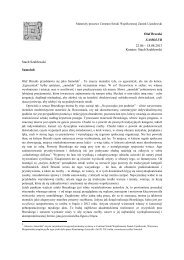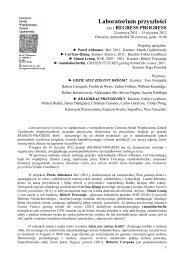KATALOG_m_zmaina alka.indd - Centrum Sztuki WspóÅczesnej - Art ...
KATALOG_m_zmaina alka.indd - Centrum Sztuki WspóÅczesnej - Art ...
KATALOG_m_zmaina alka.indd - Centrum Sztuki WspóÅczesnej - Art ...
You also want an ePaper? Increase the reach of your titles
YUMPU automatically turns print PDFs into web optimized ePapers that Google loves.
1. Rules of the game<br />
The Rules of the Game, a work by a Mexican<br />
artist Gustavo <strong>Art</strong>igas, consisted of playing<br />
two games simultaneously in the same place<br />
and time. Two basketball teams from San<br />
Diego and two Mexican football teams from<br />
Tijuana met on one playing field. The match<br />
took place in a gymnasium of a secondary<br />
school on the Mexican-American border in<br />
October 2000 1 . The superposition of games<br />
on one field transferred the focus from the<br />
rules of the game mechanism to social<br />
dynamics of the situation and to a political<br />
context – fight for space, ways to work out<br />
one’s identity, ability to built a network of relations,<br />
show of skills and finally perfection in<br />
fight simulation (terminology of many games<br />
originates from the military vocabulary, e.g.<br />
attacker, defender; and in cards we will find<br />
the monarchical system). On the other hand,<br />
due to the assembly of two games, the rules<br />
of competition and the aim of the game itself<br />
became of secondary importance. They<br />
were replaced by the process of establishing<br />
relations, freeing the spectators from the rigid<br />
mechanism of reaction and creating rules of<br />
coexistence in a double reality. The title ‘rules<br />
of the game’ abstracted themselves from the<br />
game and appeared as a complex of activities<br />
and rules that are worked out daily in the<br />
process of negotiation.<br />
Game instructions for beginners and advanced,<br />
being the point of departure for the<br />
Manual CC exhibition, are a proposition for<br />
the spectator to participate in the process of<br />
creation and to look closer at the realisation<br />
methods of games invented by artists, at<br />
their structure and at the role of the spectator<br />
as the co-author of the activity. The exhibition<br />
takes places mainly when it is played, when<br />
it happens through the action and when<br />
the spectator practices instruction cards.<br />
The quality of a given work depends not<br />
only on the artist but mainly on the spectator.<br />
It is defined each time by the notion of<br />
playability, i.e. the satisfaction of the player<br />
from their participation in the game and the<br />
effectiveness of the participation strategies<br />
they set in motion. These strategies (used<br />
not only in games by many contemporary<br />
artists) assume the non-hierarchical model of<br />
cooperation between the player (spectator)<br />
and the game (its author). Due to the playability<br />
potential they can totally absorb the<br />
player, situating them in a certain established<br />
space of one-off order, at the same time setting<br />
up social relations, often surprising and<br />
completely different from the everyday logic,<br />
as the above mentioned Mexican-American<br />
superposed game.<br />
In his book Homo ludens, a Study of the<br />
Play-Element in Culture, Johan Huizinga, a<br />
Dutch historian and a culture theorist, indicates<br />
the central role of games and plays<br />
in the functioning of the culture. Analysing<br />
ludic elements present in primitive, oriental<br />
and contemporary cultures he notices that,<br />
to a larger or smaller extent, each of them<br />
originates from the play. Huizinga proves<br />
that plays and games are a culture-shaping<br />
impulse in creating social practices and institutions,<br />
and they inspire new forms of social<br />
relations 2 . The theses of Huizinga directly influenced<br />
the creation of ludology – a science<br />
devoted to analysis of games and plays,<br />
mainly the virtual ones. The ludology tries to<br />
indicate the difference between the traditional<br />
research on the products of culture, based<br />
mainly on analyses of the representation,<br />
and the game, which is not limited only to<br />
the representation but which also ‘happens’.<br />
Theorists of ludology assume that the traditional<br />
literature or culture studies, referring to<br />
the representation, ignore the dimension of<br />
action, central for games – the playability and<br />
the participation. This science was created in<br />
response to the growing importance of and<br />
133









